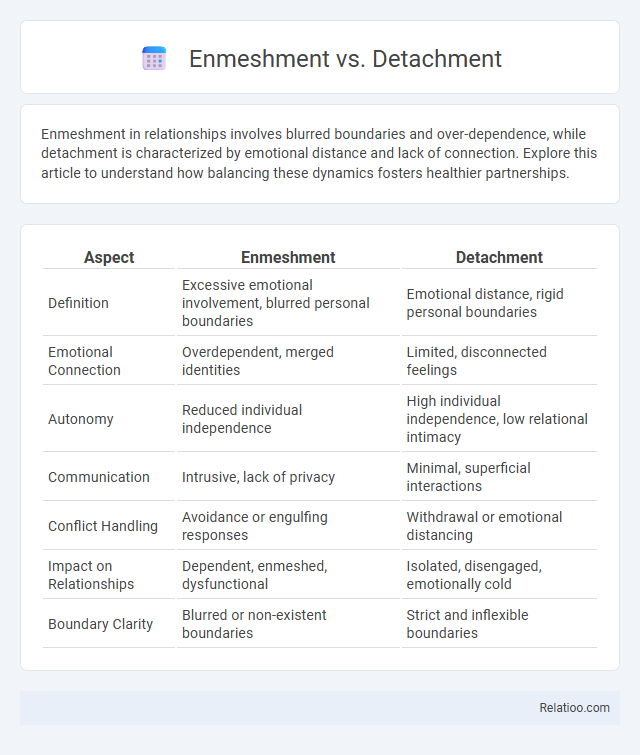Enmeshment in relationships involves blurred boundaries and over-dependence, while detachment is characterized by emotional distance and lack of connection. Explore this article to understand how balancing these dynamics fosters healthier partnerships.
Table of Comparison
| Aspect | Enmeshment | Detachment |
|---|---|---|
| Definition | Excessive emotional involvement, blurred personal boundaries | Emotional distance, rigid personal boundaries |
| Emotional Connection | Overdependent, merged identities | Limited, disconnected feelings |
| Autonomy | Reduced individual independence | High individual independence, low relational intimacy |
| Communication | Intrusive, lack of privacy | Minimal, superficial interactions |
| Conflict Handling | Avoidance or engulfing responses | Withdrawal or emotional distancing |
| Impact on Relationships | Dependent, enmeshed, dysfunctional | Isolated, disengaged, emotionally cold |
| Boundary Clarity | Blurred or non-existent boundaries | Strict and inflexible boundaries |
Understanding Enmeshment: Definition and Signs
Enmeshment occurs when personal boundaries between family members or individuals become blurred, leading to an excessive emotional involvement that hinders autonomy. Key signs of enmeshment include difficulty making independent decisions, a lack of privacy, and feeling responsible for others' emotions or problems. Recognizing these patterns is essential for establishing healthy boundaries and fostering emotional independence.
Exploring Detachment: What It Really Means
Detachment involves maintaining emotional boundaries and perspective, allowing you to observe situations without becoming overly involved or reactive. Unlike enmeshment, where personal boundaries blur and emotions intertwine excessively, detachment promotes healthier relationships through balance and self-awareness. Understanding detachment can help you manage stress and improve your interpersonal connections by fostering emotional independence without coldness or avoidance.
Key Differences Between Enmeshment and Detachment
Enmeshment involves overly blurred boundaries where personal identities and emotions become intertwined, leading to a loss of individual autonomy, whereas detachment is characterized by excessive emotional distance and disengagement, creating isolation and a lack of connection. You can recognize enmeshment by patterns of control, dependency, and difficulty making independent decisions, while detachment often results in withdrawal, emotional numbness, and avoidance of intimacy. Understanding these key differences helps in identifying and addressing unhealthy relationship dynamics effectively.
Psychological Roots of Enmeshment
Enmeshment arises from blurred emotional boundaries within family systems, often rooted in childhood experiences where caregivers fail to foster individual autonomy, leading to codependent relationships and identity diffusion. Detachment, conversely, stems from emotional neglect or trauma, causing individuals to withdraw and develop rigid boundaries to protect themselves from further harm. Understanding these psychological roots highlights how enmeshment reflects an overinvolvement in others' lives driven by unmet emotional needs, while detachment represents an adaptive response to emotional abandonment or invalidation.
Causes and Effects of Detachment in Relationships
Detachment in relationships often stems from emotional neglect, trauma, or prolonged stress, leading individuals to create psychological distance to protect themselves. Your emotional withdrawal can result in a lack of intimacy, miscommunication, and increased feelings of loneliness, negatively impacting the connection with your partner. Understanding these causes and effects is crucial for fostering healthier attachment patterns and improving relationship dynamics.
Impact of Enmeshment on Mental Health
Enmeshment in family dynamics leads to blurred personal boundaries, causing individuals to struggle with identity and increased anxiety. This over-involvement often contributes to emotional dependence, low self-esteem, and difficulty in establishing healthy relationships, exacerbating symptoms of depression and stress. In contrast, detachment fosters autonomy and emotional resilience, highlighting the detrimental impact enmeshment has on mental health by limiting personal growth and emotional regulation.
Healthy Boundaries: The Balance Between Connection and Independence
Healthy boundaries establish the balance between enmeshment and detachment by fostering your ability to connect deeply while maintaining independence. Enmeshment occurs when personal identities and emotions become overly intertwined, leading to loss of autonomy and increased emotional dependence. In contrast, detachment creates excessive emotional distance, hindering intimacy and genuine connection essential for relational well-being.
Recognizing Unhealthy Patterns in Relationships
Recognizing unhealthy patterns in relationships involves identifying enmeshment, where boundaries are blurred and individuals lose their sense of autonomy, and detachment, characterized by emotional distance and lack of connection. Enmeshment often leads to dependency and difficulty distinguishing personal identity, while detachment results in isolation and suppressed emotions. Awareness of these dynamics is crucial for fostering healthy boundaries and emotional well-being in interpersonal connections.
Healing from Enmeshment and Overcoming Detachment
Healing from enmeshment involves establishing clear personal boundaries and developing a strong sense of self separate from others. Overcoming detachment requires reconnecting with your emotions and fostering healthy relationships based on trust and vulnerability. Both processes emphasize reclaiming autonomy and emotional balance for long-term psychological well-being.
Practical Strategies to Foster Secure Attachment
Practical strategies to foster secure attachment emphasize clear boundaries, consistent emotional availability, and empathetic communication to prevent enmeshment and detachment. Encouraging individual autonomy while maintaining supportive connections promotes healthy relational patterns and emotional regulation. Regular check-ins and validation of feelings enhance trust and reinforce secure attachments within families or therapeutic settings.

Infographic: Enmeshment vs Detachment
 relatioo.com
relatioo.com